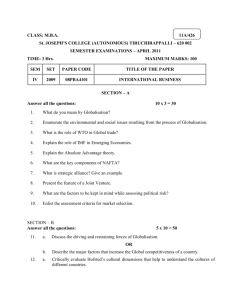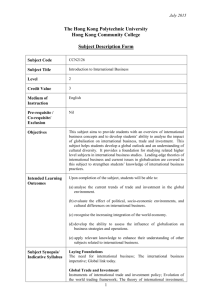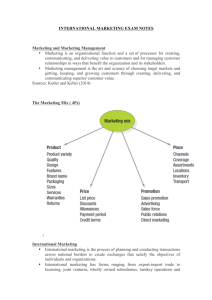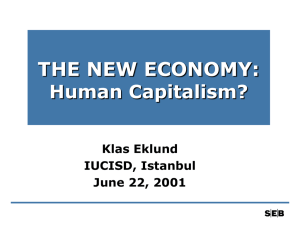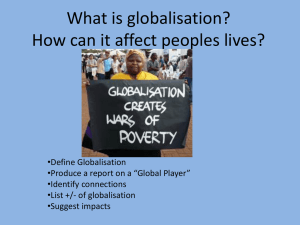Globalisation and the International Financial Architecture: Writing (and Righting) the Rules
advertisement
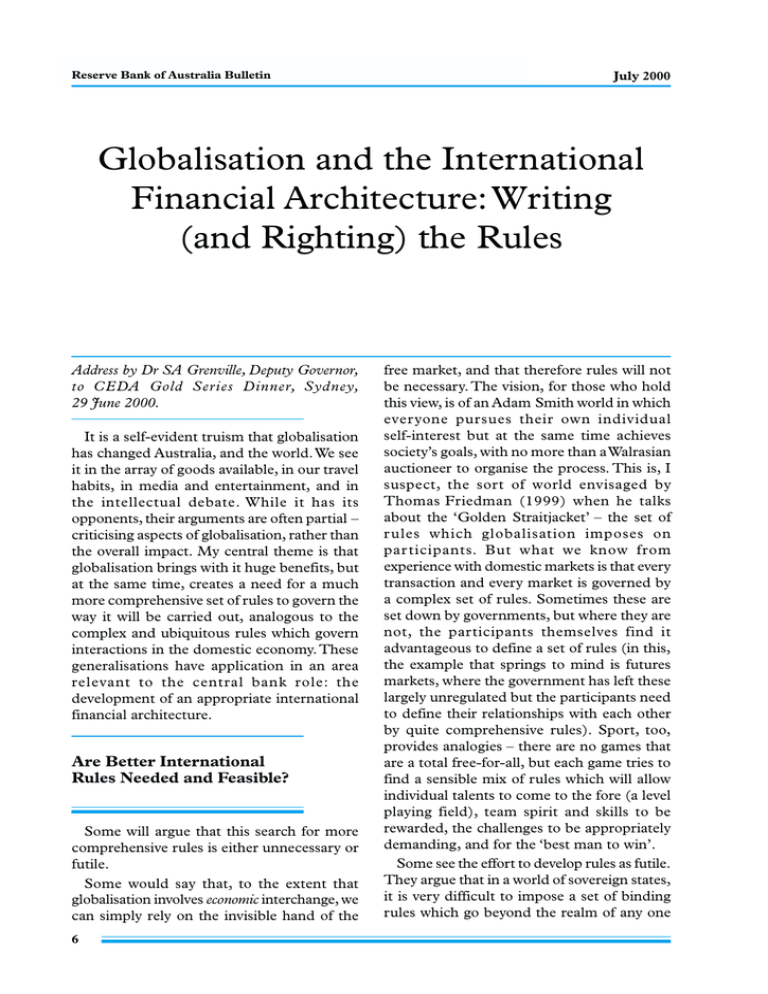
Reserve Bank Australia Bulletin Globalisation andofthe International Financial Architecture:Writing (and Righting) the Rules July 2000 Globalisation and the International Financial Architecture: Writing (and Righting) the Rules Address by Dr SA Grenville, Deputy Governor, to CEDA Gold Series Dinner, Sydney, 29 June 2000. It is a self-evident truism that globalisation has changed Australia, and the world. We see it in the array of goods available, in our travel habits, in media and entertainment, and in the intellectual debate. While it has its opponents, their arguments are often partial – criticising aspects of globalisation, rather than the overall impact. My central theme is that globalisation brings with it huge benefits, but at the same time, creates a need for a much more comprehensive set of rules to govern the way it will be carried out, analogous to the complex and ubiquitous rules which govern interactions in the domestic economy. These generalisations have application in an area relevant to the central bank role: the development of an appropriate international financial architecture. Are Better International Rules Needed and Feasible? Some will argue that this search for more comprehensive rules is either unnecessary or futile. Some would say that, to the extent that globalisation involves economic interchange, we can simply rely on the invisible hand of the 6 free market, and that therefore rules will not be necessary. The vision, for those who hold this view, is of an Adam Smith world in which ever yone pursues their own individual self-interest but at the same time achieves society’s goals, with no more than a Walrasian auctioneer to organise the process. This is, I suspect, the sort of world envisaged by Thomas Friedman (1999) when he talks about the ‘Golden Straitjacket’ – the set of r ules which globalisation imposes on par ticipants. But what we know from experience with domestic markets is that every transaction and every market is governed by a complex set of rules. Sometimes these are set down by governments, but where they are not, the participants themselves find it advantageous to define a set of rules (in this, the example that springs to mind is futures markets, where the government has left these largely unregulated but the participants need to define their relationships with each other by quite comprehensive rules). Sport, too, provides analogies – there are no games that are a total free-for-all, but each game tries to find a sensible mix of rules which will allow individual talents to come to the fore (a level playing field), team spirit and skills to be rewarded, the challenges to be appropriately demanding, and for the ‘best man to win’. Some see the effort to develop rules as futile. They argue that in a world of sovereign states, it is very difficult to impose a set of binding rules which go beyond the realm of any one Reserve Bank of Australia Bulletin government. There is much force in this argument, and the only counter is to say that, one way or another (either through agreements between gover nments or informally-developed rules), there are already a complex (if not comprehensive) set of international rules in a wide variety of areas. International co-operation on postal services, telecommunications, and (less successfully) airlines are all relevant examples. The feasibility of developing these further will depend on the nature of the rules required. Some rules will benefit all parties (common sense or ‘win/win’ rules), and agreement on these should be possible. Such cases are not trivial – there are many examples where agreement benefits all: I see these as analogous to the rule which determines which side of the road cars will travel on in a particular country – it does not matter much which side, but it is important that everyone has a clearly-understood set of rules which they stick to. For those with a sporting bent, the examples might be the uniformity of sporting codes internationally: everyone plays soccer to the same set of rules, because it works better that way. These are the easy cases, which do not involve serious distributional issues, where the rules determine winners and losers. But even with thorny distributional issues, domestic jurisdictions successfully arbitrate over distribution and property rights. While rules of this nature will be intrinsically much harder to formulate and enforce internationally, the domestic political process shows that it is possible to achieve general community acceptance of such rules (even when they discriminate or disadvantage a particular group in the community). The same needs exist internationally: only the process is deficient. Technology and the Global Imperative Not only is globalisation bringing countries closer together and integrating them more fully, but the nature of technology is ensuring July 2000 that the goods (and, increasingly, services) being traded are a bad fit for the Adam Smith free-market model (or the Ricardian cloth-for-wine model).The old economy, with its bales of wool and slabs of steel, is being replaced by an economy in which services are much more important, and in which information goods or knowledge goods are far more important in consumers’ purchases, and are readily internationally traded. The central characteristic of these goods, which takes them outside the bounds of the simple free-market equilibrium model, is that the marginal cost is much less than the average cost. This not only applies to ‘weightless’ knowledge goods, but for many physical goods, the cost of producing the first is enormous (research and ‘tooling up’ costs), while the cost of producing another unit is minimal (e.g. pharmaceuticals). The usual rules of economics are either inapplicable or their application is vastly more complicated. No longer will a producer increase output until marginal cost equals price.For goods whose marginal cost is low or zero, the producer has to find a way of avoiding selling goods at marginal cost, because this would leave total costs unmet. To add to the inconvenient lack-of-fit with the free-market equilibrium model, information goods and many of the new service goods have the characteristics of public goods: in the jargon, they are both non-rival and non-excludable – one person’s consumption does not diminish the availability for others, and it is difficult or impossible to exclude one person from consuming these goods. Add to this the idea of networking goods (where the number of consumers of the network increases the benefit to each of them, such as a telephone system), and the greater opportunities for ‘winner-takes-all’ outcomes (where the world-renown sport or entertainment star displaces all the local heroes), and the market dynamic differs greatly from the textbook model. These characteristics force producers in two important directions – towards creating some elements of monopoly attaching to their 7 Globalisation and the International Financial Architecture:Writing (and Righting) the Rules production, and to seek larger and larger markets. Larry Summers (2000, p 2) captures the first point this way: ‘The constant pursuit of that monopoly power becomes the central driving thrust of the new economy’. On the second, Zuckerman (1998, p 20), in triumphalist mode, says: ‘On the brink of the 21st century, the United States is at a point reminiscent of its entry into the twentieth … Today, of course, the new frontier is the global economy’. There is a common belief that the most obvious manifestation of new technology – the Internet – operates in a world without rules. The Economist (2000a, p 77) put it this way: ‘There is nothing like an absence of regulation for stimulating innovation. Such was the creed of early Internet enthusiasts. The myth that the Internet has thrived only because it is anarchic is now firmly entrenched’. But The Economist goes on to note that even the anarchic Internet is subject to myriad rules: ‘In fact, cyberspace is highly organised and even regulated, and not just for technical standards’.1 This sounds very ‘New Economy’. Just how new these concepts are remains a moot point. For instance, Thomas Jefferson gave probably the best description of the public good nature of information when he said ‘He who receives an idea from me, receives instruction himself without lessening mine; as he who lights his taper at mine, receives light without darkening me.’ (quoted by Summers (2000, p 2)). Some of the characteristics of the New Economy are variants on the old ‘economies of scale’. But this does not diminish the motivation of producers to become monopolists. Whether or not these concepts are an example of old wine in new bottles is beside the point: the July 2000 powerful dynamic of globalisation is clear in the figures. World trade has grown at more than twice the pace of GDP growth for decades, and foreign direct investment rose six-fold during the decade to 1996 (compared with a mere doubling of domestic investment in the same period). Faced with this reality, we have to find a set of rules which allows and encourages these low-marginal-cost goods to be produced (the development costs have to be recouped) without the dead-weight costs of monopoly. We need a set of rules which provides a fair and efficient international game.2 If the reaction of the individual producer (the quasi monopolist) is to defend and enlarge their monopoly power, then we see this same tendency among nations to pursue their own narrow self-interest. Hal Varian (1999) quotes a neat example from US history of how perceived self-interest was pursued, and also how the incentives might change over time, altering the rules. The United States refused to extend copyright to inter national authors until the late 19th century, being a large (free-riding) consumer of the books which had been written elsewhere, particularly in England. As the balance of American authorship changed, the United States finally granted copyright protection to international authors (as well as its own), but in order to continue to provide protection to American typesetters, insisted that this copyright protection extend only to those foreign works that were typeset in the United States. This provision remained until the mid 1960s. While we have noted that where governments do not lay down rules, private individuals will tend to work out their own 1. And, of course, the Internet began as a public-sector (US Defence Department) project. 2. While some of the rules will be directed at these New Economy characteristics, other rules should be aimed at enhancing competition and all the elements which go with a well-functioning market system. So the general thrust of the WTO towards greater opening-up of international trade and the policies embodied in the ‘Washington Consensus’ (deregulation and opening-up of markets) is, of course, still very important. Some fine distinctions are needed here: deregulation does not mean ‘no rules’: as detailed, intrusive, prescriptive regulations are relaxed, they should be replaced by general rules-of-the-game. This distinction may seem subtle, but it is the one which applied to the process of domestic financial deregulation in Australia: as the old prescriptive rules were dismantled, they had to be replaced by the broad framework of prudential supervision. 8 Reserve Bank of Australia Bulletin set of rules, perhaps the most interesting cases are where individual producers have managed to set the rules and then co-opt the state to enforce their rules. At one level, one might ask why our own authorities should prevent us from buying fake brand-name designer-goods, and pirated CDs and software, when the main beneficiary of the higher prices we currently pay is a foreigner. This is obviously a controversial area, and before I get into trouble here, I should also acknowledge that as soon as we admit that there are legitimate things such as intellectual property rights, then there is a strong case for getting the state’s apparatus to defend these, in the same way that it defends other property rights such as our cars and our houses. But having acknowledged the importance of the concept of intellectual property rights, the unanswered issue then is exactly what value we should put on these. When I go to buy a copy of Microsoft Windows for $200, say, is this the ‘correct’ price, in the sense of giving an appropriate incentive for software producers to go on producing software and selling it in Australia? There is clearly a powerful case for such protection (to reward and encourage innovation), but one would have more faith in the economic rationale behind this if it were not so heavily based on legislation and rules from the horse-and-buggy era. Is the duration of a patent, as legislated for the steam age, still appropriate for the electronic age? Should the idea of a patent be so wide as to allow, for example, proprietary control of an industry standard? I find this a fascinating area, and could be drawn into this debate on whether patent protection should be provided for general ideas (the classic example is Amazon’s protection for the idea of ‘single-click purchasing’), but this would take me too far afield. I have strayed well outside the usual territory of central bankers, and I am going to get back, now, onto familiar ground – to discuss the New International Financial Architecture. But I want to key off from the generalities July 2000 discussed so far: that successful globalisation will require a set of rules no less complex than the rules which govern domestic economies. These rules will have to address the strong monopolistic dynamic of the New Economy and the self-interested motivation of individual countries. These rules have to be hammered out under the most difficult of circumstances, where there is no well-established political process to adjudicate between rival claims and achieve some kind of consensus. Nevertheless, we have to try to do this, because if we do not, the rules will be hammered out by others, and not necessarily in our best interests. Again, I would refer back to the Thomas Friedman idea that a Golden Straitjacket has been developed (and will be further developed) and that countries will, to a greater or lesser degree, have to adjust to it, like it or not. The need is to find some kind of decision-making process (because, after all, the Golden Straitjacket is not the product of some impersonal Adam Smith free market process) to write (and right) the rules governing the financial relationships between countries. The post-war period produced the Bretton Woods rules – a great improvement on the gold standard. The motivation which produced the Bretton Woods institutions (the IMF and the World Bank) has been lost, but needs to be regained if we are to achieve an appropriate New Financial Architecture. Rules and the Asian Crisis The Asian crisis revealed significant weaknesses in the rules gover ning international capital flows, and those relevant to the international response to a crisis: • the IMF is seen, by many of us, to have been misguided in aspects of its response, at least to some of the countries in crisis (and here I am thinking in particular of Indonesia). A better deliberative process might have eased this problem; 9 Globalisation and the International Financial Architecture:Writing (and Righting) the Rules • the international discussion and decision-making process seemed quite unrepresentative, with many of the rules being formed in quite narrow groups such as G7 and G10.3 Even where there are wider groups such as the IMF itself, the debate was dominated by one (or a few) voices. As the crisis developed, a more representative body (G22) was formed, which did important work not so much in the resolution of the crisis as it was occurring, but in preparing for the re-writing of some of the rules. I have talked elsewhere about some of the issues which required new or different rules, and the real progress which has been made in addressing these issues.4 These issues are: • bailing-in the private sector (also known as ‘burden-sharing’); • hedge funds; • the volatility of capital flows and what might be done about this. I will not go over this territory again, but I would just record that in each of these areas there is a domestic analogue, governed by rules which are accepted as beneficial. Within domestic jurisdictions, each country has a set of bankruptcy and liquidation rules, which acknowledge that things can go sufficiently wrong for a business that it makes sense for the enterprise to be wound up, prior contracts rescinded, and provides equitable rules to govern this process. Similarly, domestic rules govern the behaviour and obligations of mutual funds. And in many countries there are arrangements, in extremis, for lender-of-last-resort for core institutions of the financial sector. In each of these cases, the rules have been devised because the untrammelled working of the free market does not produce an optimal (or even acceptable) result. Perhaps the most important success coming out of the discussions on international July 2000 architecture is the more representative network of discussion (and perhaps even decision-making) bodies: • the IMF has done a certain amount of introspection and will do more; • the Bank for International Settlements (the central banks’ international co-ordinator) has greatly enlarged its membership (in particular from Asia) and has swung decisively away from its earlier European orientation; • while G22 was disbanded (largely because of pressure from the smaller Europeans who felt excluded in the new process), a worthy successor – G20 – has been set up. The Financial Stability Forum has been created to co-ordinate prudential rule-making. The FSF has the technical expertise and representation to formulate rules and guidelines for the financial sector, and G20 has the clout to put them in place. It is now up to the various participants (including Australia, which is represented on both the FSF and the G20) to make sure that G20 becomes an effective forum for achieving consensus among a core group of countries. This battle is far from won. I said earlier how difficult it is to develop international rules, beyond any individual sovereign jurisdiction, and with the hope of enforcing them. But we may be able to make some progress on those rules which are, drawing on my earlier distinction, common sense or ‘win/win’ – the Basel Capital Accord (which lays down prudential rules for banks) was of this nature. I should note, here, that it is not necessary, in gaining acceptance of rules, for every single player to be a winner always. The sporting analogy may be helpful: all that is required is for the players to agree to abide by a set of rules. Some players may ‘spit the dummy’ or ‘take their bat home’: but most accept that, in the long run, it is sensible to 3. G10 – in its manifestation as the Basel Committee on Banking – provides a neat example of rule-writing. It set down the Basel Rules on Bank Capital, which became the rules for all banks worldwide, even though they had been written for G10 banks. 4. See Grenville (1999a, 1999b). 10 Reserve Bank of Australia Bulletin stick to a set of rules under which they sometimes lose. We may even be able to find some forum for trade-offs where the issues are those more difficult ones involving distributional decisions. If success is to be achieved, it is more likely to come from different sets of rules reached between experts in individual fields of expertise, rather than one great centralised rule-making process (like the UN).5 We already see international forums which grapple with specific problems – WTO is one example, although it is not an unalloyed success. In any rule-making process, there is a danger of over-prescription. Within domestic jurisdictions, this is an ever-present concern – that governments are asked to use regulation to fix every problem. Domestically, there is now healthy scepticism that rules can provide the universal fix-all. In the international arena, the starting point is not one of over-regulation. Widespread acceptance of the starting point given by the Washington Consensus (‘deregulate and open-up internationally’) and acceptance of an international version of the medicos’ dictum ‘first do no harm’ should avoid the mistakes of over-zealousness. Part of a good rule-making regime is a recognition that parsimony is a virtue and that some rules are bad – where vested interests or misguided lobby groups gain influence in the process, we can end up with the wrong rules. July 2000 Conclusion My starting point was that globalisation has been enormously beneficial for Australia, and for the world. Even if we cannot design a perfect set of rules to govern its development, it will go on being enormously beneficial, and most will share in that process. But this does not in any way diminish the importance of trying to ensure that the rules are appropriate both in their technical aspects (providing the right incentives for further innovation and dissemination of ideas), and in an income-distribution sense, both between countries and within countries. During the Asian crisis, Larry Summers (1998) argued that we would not wish to restrict the use of airline travel just because of the occasional plane crash, and by analogy that we would not want to slow globalisation. This seems to me to be correct, but to emphasise the wrong issue: we respond to crashes (and crises) by putting in place rules, regulations and procedures to diminish the chance of a recurrence, and to be better prepared should that eventuality arrive. Australia cannot, as a medium-sized player on the international stage, hope to dominate the outcomes or achieve all its objectives. But we need to be at the table, to speak up, and to work actively for a better set of international rules, not only for the set of issues encompassed by the international financial architecture, but for the entire gamut of the globalisation process. 5. Although the UN is attempting to co-ordinate international patents – see The Economist (2000b). 11 Globalisation and the International Financial Architecture:Writing (and Righting) the Rules July 2000 References Friedman TL (1999), The Lexus and the Olive Tree, Farrar, Straus and Giroux, New York. Grenville SA (1999a), ‘Financial Crises and Globalisation’, Reser ve Bank of Australia Bulletin, August , pp 43–55. Available at <URL:http://www.rba.gov.au>. Grenville SA (1999b), ‘The International Reform Agenda: Unfinished Business’, Reser ve Bank of Australia Bulletin, December, pp 6–15. Available at <URL:http://www.rba.gov.au>. Summers LH (1998), ‘Go with the flow’, Financial Times, 11 March. Summers LH (2000), ‘The New Wealth of Nations’, remarks by Treasury Secretary, Hambrecht and Quist Technology Conference, San Francisco, 10 May. Available at <URL:http://www.ustreas.gov/ press/releases/ps617.htm>. 12 The Economist (2000a), ‘Regulating the Internet: The consensus machine’, 10 June, pp 77–79. The Economist (2000b), ‘Patent Law: Going global’, 17 June, p 99. Varian HR (1999), ‘Markets for Information Goods’, Bank of Japan IMES Discussion Paper No. 99/E/9. Zuckerman MB (1998), ‘A Second American Century’, Foreign Affairs, May/June, 77(3), pp 18–31. R
